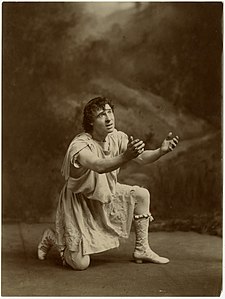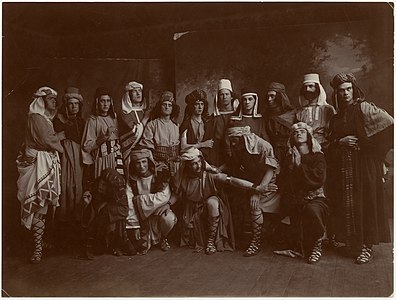fiction.wikisort.org - Movie
Corianton: A Story of Unholy Love is a 1931 film based on the story of Corianton, the son of the prophet Alma in the Book of Mormon. Corianton appears only briefly in three passages in the Book of Mormon.[1][2][3] However, as scholars Randy Astle and Gideon Burton point out, his story is one of the only stories in the Book of Mormon "with any sex in it", which has made it a popular subject of Book of Mormon-themed fiction and drama for more than a century.[4]
| Corianton: A Story of Unholy Love | |
|---|---|
 | |
| Directed by | Wilfrid North |
| Written by | Orestes Utah Bean |
| Based on | Corianton: A Nephite Story (1902) by B. H. Roberts; A Ship of Hagoth (1896) by Julia McDonald; Corianton: an Aztec Romance by Orestes Utah Bean |
| Produced by | Lester Park Bryan Park |
| Starring | Eric Elden Reginald Barlow Theo Pennington Herschel Mayall Joseph Smiley The Mormon Tabernacle Choir |
| Music by | Edgar Stillman Kelly |
Release date |
|
| Country | USA |
Before the film was made, the Corianton story had been the basis of two novellas (including one by an LDS general authority), one traveling stage play, and one Broadway play with music by a Broadway composer. The film brought in elements from all of these previous works but was ultimately unsuccessful and resulted in multiple lawsuits against the producers by their financial backers. In 2009, the film was restored by archivists at Brigham Young University.
Plot
As the film begins, Korihor, the anti-Christ, is preaching in Zarahemla, and the people of the city are talking about his upcoming trial with Alma, who is both the prophet of the Church and the chief judge of the land. Corianton, Alma's son, has fallen under Korihor's sway and argues with his brother, Shiblon, that no man should be punished for his beliefs. Korihor is brought before Alma, who accuses him of tempting God, to which Korihor replies, "I deny thy God!"—after which he is instantly struck dumb by a bolt of lightning.
Corianton is shaken up by Korihor's fate, and he re-converts to his father's religion and agrees to be part of a missionary force to the Zoramites, a people who have fallen away from the Church. Corianton proves to be a powerful missionary, raising the concern of the Zoramite prince, Seantum, who knows of Corianton's attraction to Korihor and decides to set a trap for him that will bring down his father's mission. Seantum conspires with his lover, Isabel, to set a trap for the young missionary. Under the pretense of being interested in Corianton's message, Isabel entices him to attend a party at Seantum's palace. The party turns out to be a drunken, libidinous affair, and Seantum spreads the word far and wide that Corianton has been drinking and carousing with a prostitute.
In the process of trying to seduce Corianton, Isabel falls genuinely in love with him. She begs his forgiveness and begins to conspire to help him prove that he was tricked. Shiblon comes to Seantum's palace to find Corianton, and Isabel asks him to take her with him when they escape. Shiblon refuses and condemns Isabel for her sins. Corianton, too, rejects her when she claims to have repented and asks to go with him. Seantum comes upon Shiblon and kills him before he reaches Corianton.
Isabel continues to profess her repentance and love for Corianton, who continues to reject her. Seantum raises his armies to march on Zarahemla. He comes upon Isabel and Corianton and kills her with his sword. Corianton and Seantum fight. Corianton stops short of killing him and orders him taken captive instead, ending the threat of assault on Zarahemla. With her dying breath, Isabel pronounces Corianton innocent of sexual relations with her, leaving him free to marry the lovely Relia, who had always been in love with Corianton but had been betrothed to Shiblon by her parents.
Cast
- Eric Elden as Corianton
- Reginald Barlow as Korihor
- Charles Edwards as Alma
- Alis Frost as Relia
- William Joy as Zebu
- Marion Martin as Sun Goddess
- Ignacio Martinnetti as Bastol
- Herschel Mayall as Laman
- H. H. McCullum as Amuioki
- Theo Pennington as Zoan Ze Isobel
- James Phillips as Shiblon
- Lillian Savin as Manetah
- Joseph Smiley as Chief Judge
- Stephen Wright as Lamarck
- Emil Yousoff as Prince Seantum
Production
Background and sources
The film version of Corianton was the culmination of intense interest in the story among Latter-day Saints at the end of the 19th and beginning of the 20th century. The first use of the story as imaginative literature was by editor and LDS general authority B. H. Roberts, who, in 1889, published a novella called Corianton over five issues of the Contributor, a journal for which he was the editor. In 1902, Roberts republished the text as a stand-alone novella called Corianton: A Nephite Story.[5]
That same year, a Utah-based playwright named Orestes Utah Bean combined Roberts' story with Julia A. McDonald's 1896 novella A Ship of Hagoth to create a stage play titled Corianton: An Aztec Romance. He did not attribute his liberal borrowings from both works.[6] With the financial backing of George Elias Blair, Bean presented the play in Salt Lake City with Joseph Hawthorn in the title role and Rose Agnes Lane in a major female part in 1902. It was criticized by critics as too long, but was a theatrical success. It failed when it went on the road to non-Mormon audiences but was then successfully revived in Salt Lake City and other smaller Utah communities.[7] A 1902 article from The Brooklyn Daily Eagle wrote that Bean's motivation in writing the play was to spread "the doctrine of Mormonism".[8]
The script continued to be improved and critics praised the shorter, 1909 version of the play. In 1912 Bean rewrote the play and called it An Aztec Romance with music by Broadway composer Harold Orlob and took it to Broadway. It had six performances but was resoundingly rejected by critics; a New York Times review described it as "sound and fury signifying nothing"; a review from The Brooklyn Daily Eagle designated it a "weird hodge-podge".[7][9][10]
- Probably Joseph Hawthorn as Corianton in the play
- the cast of Corianton (the play)
- Orestes Bean
Development and filming

In the late 1920s, Bean worked with Utah filmmaker Lester Park, and his brothers Allan and Byron, to raise operating funds and bring the Corianton story to the stage. The Parks recruited Edgar Stillman Kelly to write the music and convinced the LDS Church to have the Tabernacle Choir provide the background music.[4][11] The cost of the film was a problem, as Bean was difficult to please, and his contract with the Parks required them to pay various Bean relatives for their work as "consultants". To save on costs and to complete the film on time, the Parks filmed in black-and-white and did the majority of their filming while Bean was away at a family wedding.[12]
One major difference from the play is that, while the stage version's dancing girls were fully clothed, the film version's wore little.[12] The film was an early sound film, and actors retained habits from silent films like expressive gestures. Corianton: A Story of Unholy Love, directed by Wilfrid North, released in 1931 as one of the first commercially produced Mormon films.[13][note 1]
Reception
Corianton: A Story of Unholy Love premiered on October 1, 1931, at Salt Lake City's Playhouse Theater and ran for two weeks there and at other venues throughout Utah. It received mostly negative reviews and attracted little interest outside of Utah Mormon circles.[14] In Salt Lake City, it was compared favorably to Ben-Hur.[4][15] After its financial failure, Bean and the Park brothers faced both anger from, and multiple lawsuits by, their investors.
In January of 1932, the Corianton Corporation was placed in receivership owing $65,000 to creditors.[16] One problem was that Corianton Corporation had used money from stockholders for a project outside the film.[4] There were several lawsuits over the film, which Bean was involved in until his death.[17] In one of these lawsuits on December of 1932, Bean spent five days in jail on a contempt charge for telling a judge to "shut up".[18] The film's producers were also targeted. Author Orson Scott Card, the grandson of producer Lester Park, recalls that, after the film's failure, "Grandpa was forced to flee the state of Utah to avoid endless lawsuits and the threat of prosecution."[19]
Restoration and current status
Because of the legal issues surrounding the production of the film, most copies were destroyed, and for many years the film was considered lost.[4] In 2009, however, Orson Scott Card donated a 16mm print of the film to Brigham Young University.[20][21] The film was digitally restored and screened before a limited audience in September of 2009. In February of 2010, it was shown at a meeting of the Association for Mormon Letters at Utah Valley University in Orem.[21] The film has never been released as a video or licensed for viewing on the Internet, but it remains available for research and viewing in the L. Tom Perry Special Collections archive at Brigham Young University.[22]
References
- "Alma 31:7".
- "Alma 39:3".
- "Alma 63:10".
- Astle & Burton 2007, p. 55.
- Parshall 2022, pp. xx–xii.
- Parshall 2022, pp. xii–xix.
- Parshall 2022, pp. xx–xxii.
- "Mormons to Use the Drama as an Instrument of Conversion". The Brooklyn Daily Eagle. October 12, 1902. p. 36. Retrieved September 6, 2022.
- ""An Aztec Romance" Queer". The New York Times. September 19, 1912. Retrieved September 6, 2022.
- ""Aztec Romance" is Weird Hodge-Podge". The Brooklyn Daily Eagle. September 19, 1912. p. 7. Retrieved September 6, 2022.
- Parshall 2022, pp. xxiii.
- Parshall 2022, pp. xxiv.
- "Corianton: A Story of Unholy Love". Brigham Young University Museum of Art. 2016. Retrieved September 4, 2022.
- Parshall 2022, p. xiv.
- ""Corianton" Still at Playhouse". The Salt Lake Tribune. October 4, 1931. p. 33.
- "Receiver Appointed". The Salt Lake Tribune. January 23, 1932. p. 14.
- Parshall 2022, p. xxv.
- "Telling Judge to 'Shut Up' Brings 'Corianton' Author 5-Day Jail Term". Salt Lake Telegram. December 2, 1933. p. 7.
- Card, Orson Scott (October 8, 2009). ""Grandpa's Film Made Us Proud"". Deseret News. Retrieved September 5, 2022.
- Norm Gillespie (2008). "Peter Lafayette Frandsen Collection on Corianton". Prepared for the L. Tom Perry Special Collections, Provo, UT. Retrieved May 31, 2016.
- De Groote, Michael (March 11, 2010). "1931 Mormon film about Corianton fuels laughter — but also offers some meat". Deseret News. Retrieved September 5, 2022.
- "Collection of Corianton Film Materials, MS 3296". BYU Library-Special Collections. Retrieved September 5, 2022.
Works cited
- Parshall, Ardis E. (2022). "Introduction to the Corianton Saga". The Corianton Saga. By Common Consent Press. pp. vii–xii. ISBN 9781948218528.
- Astle, Randy; Burton, Gideon (2007). "A History of Mormon Cinema: The Second Wave". BYU Studies. 46 (2): 45–75.
Notes
- The Life of Nephi (1915) preceded Corianton: A Story of Unholy Love.[4]
External links
- Truman G. Madsen. Defender of the Faith: The Life of B. H. Roberts. Salt Lake City: Bookcraft, 1980. p. 296-297.
- Corianton: A Story of Unholy Love at the Mormon Arts Database
- Corianton: A Story of Unholy Love at IMDb
- Corianton, a Nephite story by B.H. Roberts on archive.org
Другой контент может иметь иную лицензию. Перед использованием материалов сайта WikiSort.org внимательно изучите правила лицензирования конкретных элементов наполнения сайта.
WikiSort.org - проект по пересортировке и дополнению контента Википедии


